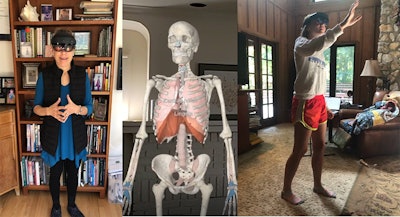
A program that uses holograms to teach human anatomy at Case Western Reserve University didn't miss a beat when COVID-19 hit in March. It distributed nearly 200 holographic headsets to students so they could continue learning at home, according to a talk at the Society for MR Radiographers & Technologists (SMRT) virtual meeting.
Holography lends itself well to remote learning, and Case Western medical students were able to continue their studies of human anatomy largely uninterrupted, according to Mark Griswold, PhD, a professor of radiology at the university who has led the project.
In fact, their experience raises existential questions about what it really means for people to be "together," he told attendees at an SMRT 2020 plenary session -- a question that is being asked more frequently during the pandemic.
Goodbye, cadavers
Griswold has been involved with advanced visualization technologies for a number of years, and he helped create the HoloAnatomy mixed-reality software that Case Western has been using for anatomy education since 2015. In fact, the software has been so effective that when Case Western opened its new Health Education Campus in coordination with Cleveland Clinic in July 2019, the facility did not include a cadaver lab.
In his Saturday plenary presentation at ISMRM 2020, Griswold updated a talk he gave at ISMRM 2019 on the holographic anatomy project. Using the HoloAnatomy software in conjunction with Microsoft's HoloLens headset, medical students are able to navigate holograms of the human body that have been painstakingly created using medical images and annotations. Students can navigate through the body and interrogate organs, all without picking up a scalpel.
The holography project has been popular with medical students, but is it effective? Case Western performed studies that compared holography education with the traditional cadaver-based approach, and it found that students learned the same amount of material in 3.6 hours with holograms as they would have in six hours in the cadaver lab. And eight months later, they scored 44% higher on anatomy tests, indicating better retention with the holographic approach, Griswold said.
But Case Western's holography program got its biggest test in March, when the COVID-19 pandemic hit the U.S. The first COVID-19 case was reported in Ohio on March 9, which happened to correspond to when Case Western students were on spring break. The decision was quickly made that students wouldn't be returning to the university.
Griswold and others at the holography project swung into action. They procured 185 HoloLens headsets and set to sanitizing the headgear and packing them in shipping boxes. The headsets were then shipped to Case Western students at their homes across North America. The HoloAnatomy software -- previously used exclusively in a classroom setting -- was then adapted for online teaching.
One week later, the students had been trained in remote use of HoloAnatomy, and remote instruction had begun. In his SMRT 2020 talk, Griswold showed videos of how students were learning anatomy from their basements, living rooms, and other locations.
 Case Western's HoloAnatomy software enables medical students to learn human anatomy at home, as Mark Griswold, PhD, pointed out during his plenary address at SMRT 2020.
Case Western's HoloAnatomy software enables medical students to learn human anatomy at home, as Mark Griswold, PhD, pointed out during his plenary address at SMRT 2020.As they did with the original launch of holographic instruction, Case Western surveyed students about their opinion of the new mode of learning, finding that 58% preferred the remote session to the classroom instruction. The students had more room to move around the body at home, and they didn't have to go to a lab to get the HoloLens hardware. Many students were also getting together in informal learning sessions of four and five individuals. Even though they were spread across the country, they still felt like they were together, Griswold said.
Holographic anatomy education could have much broader implications beyond just Case Western or the U.S., Griswold believes. It could be used in developing countries that may never have access to a cadaver lab, or it could be a good option in societies that have religious concerns about working with cadavers.
Griswold also discussed other radiological uses of holography and mixed reality apart from education, such as intraoperative uses like guiding the track of a needle during an interventional procedure. As with education, physicians could be performing mixed-reality interventional procedures from anywhere in the world, Griswold noted.
But it took the disruption created by the COVID-19 pandemic for HoloAnatomy to truly demonstrate its flexibility and its wider use.
"We really think that it seems to have worked during this pandemic time," Griswold concluded. "Students didn't miss a day of class and we are really starting to think about the global implications."
In the question-and-answer session at the end of the talk, SMRT president Shawna Farquharson asked Griswold if one explanation for the program's success with students could be its novelty. He answered that Case Western has tried to research that question, but the answer hasn't been easy to come by.
"The way we looked at it, it's clear just by watching that students are more engaged," Griswold said. "It could be because it's novel, but from where I sit, to be honest, I don't care. Students are showing up and they are engaged, and ... that's fine."



















